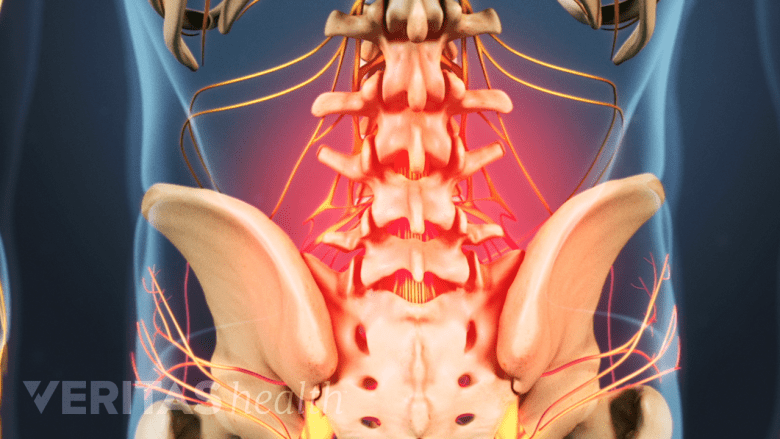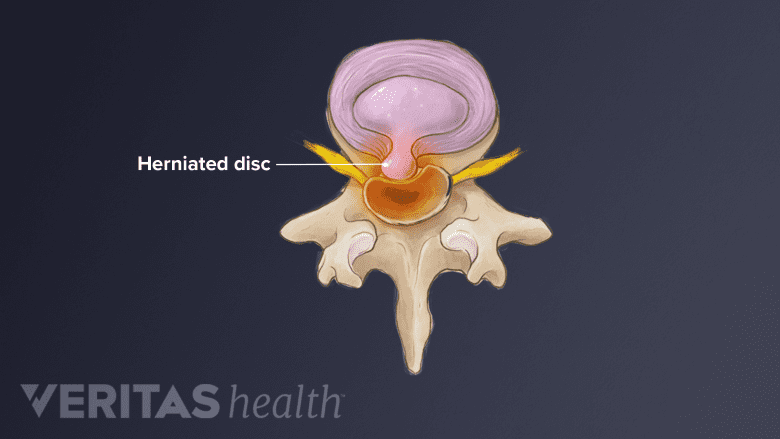Muscle strain on the left side of the spine is the most common source of lower left back pain. Strain on the muscles supporting and surrounding the spine may come from overuse, or from simple injuries such as uncomfortable sleeping positions or prolonged standing or sitting.
In This Article:
- A Guide to Lower Left Back Pain
- Lower Left Back Pain from Spinal Structures
- Lower Left Back Pain from Internal Organs
- Lower Back Pain Causes and Symptoms Video
Symptoms of Muscle Strain

Low back strain may commonly present with localized pain and a restricted range of motion.
The following are the symptoms:
- Localized pain in the lower left back.
- Pain may be described as sharp, and it may be severe
- Pain that increases if the muscle is moved beyond its restricted range of motion
- Tenderness to the touch
- Muscle spasms
- Pain that subsides with rest, such as sitting in a supported, reclining position
See Lower Back Muscle Strain Symptoms
Lower left back pain may also be caused by issues involving spinal column structures, such as the facet joints or intervertebral discs.
See Lumbar Spine Anatomy and Pain
These conditions are likely to occur on both sides of the spine, and typically the resulting low back pain is centered across the back. However, it is possible that conditions of the spinal column can cause low back pain felt mostly on the left side.
Pain should be examined by a physician if it lasts longer than 4 to 6 weeks, or does not respond to treatment methods such as a day or two of rest, over-the-counter pain medications and hot/cold packs.
Lower Left Back Pain from the Spinal Column
Lower left back pain can also be caused by damage or injury to the structures in the spinal column, including the vertebrae, spinal joints, and connective tissues. The most common issues of the spinal column include:
Herniated Lumbar Disc

A lumbar herniated disc may cause nerve root inflammation and low back pain.
An intervertebral disc can herniate on the left side of a vertebral segment, causing dull low back aches and sharp, stabbing pain that runs through the left hip and down the back of the left leg. Most often, pain in the left leg is worse than back pain. Lower left back pain and leg pain may increase after prolonged sitting. A similar condition, degenerative disc disease, is not likely to cause pain on only one side.
See Lumbar Herniated Disc: What You Should Know
Facet Joint Pain (Osteoarthritis)
Age-related wear and tear commonly affects one or both of the facet joints at the back of the vertebra, resulting in stiffness, discomfort, and dull aches. A bone spur on the left side of the lower spine can irritate nerve roots, causing shooting pain through the left hip and down the left leg.
Sacroiliac Joint Dysfunction

Abnormal movement in the sacroiliac joint is a cause of low back pain.
The sacroiliac joint can cause low back and pelvic pain on one or both sides of the body if its normal range of motion is disrupted. Too much movement in the joint may cause lower left back pain and/or hip pain, which may radiate into the groin. Too little movement typically causes lower left back pain that radiates into the buttocks or down the leg. Ankylosing Spondylitis often starts with sacroiliac joint pain.
See Sacroiliac Joint Dysfunction (SI Joint Pain)
The first course of action for these conditions is usually non-surgical treatment, including manual manipulation, massage therapy, physical therapy, and/or over-the-counter or prescription pain medication. Treatments vary according to the condition and the patient’s symptoms. Surgical treatment is considered when back pain is so persistent or severe that it interferes with a patient’s ability to function.
Less Common Sources of Lower Left Back Pain

Degenerative spondylolisthesis may strain the lower back muscles and compress the nerve roots.
Other conditions causing lower left back pain may include either local problems with the spine or far-reaching conditions affecting the overall musculoskeletal system, such as:
- Degenerative spondylolisthesis, in which one vertebra slips forward over the one below it due to normal degenerative changes in the spine’s discs and joints. It is common for this condition to cause radicular pain on one side of the back.
- Chronic pain syndromes, such as fibromyalgia and myofascial pain syndrome, which cause full-body musculoskeletal pain, fatigue, and tenderness in areas called trigger points.
Read more about chronic pain syndromes on Arthrits-health.com.
Other possible causes are relatively rare, such as a spinal tumor, fracture, or an infection in the lower left spine.

